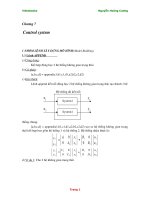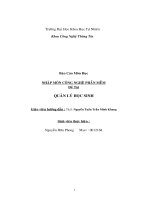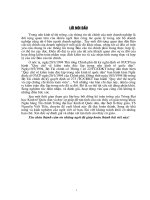8Deter~1.Doc
Bạn đang xem bản rút gọn của tài liệu. Xem và tải ngay bản đầy đủ của tài liệu tại đây (647.09 KB, 106 trang )
MINISTRYOFEDUCATIONANDTRAINING
THE STATE BANK OFVIETNAM
BANKINGUNIVERSITYOF HOCHIMINHCITY
GRADUATETHESIS2020-2021
DETERMINANTS OF STUDENTS'
SCHOLASTICACHIEVEMENT – A PRACTICAL
CIRCUMSTANCEATBANKING INSTITUTE
OFHCMC
HOANG THI KIM
KHANHBUSINESS
ADMINISTRATIONSUBJECTCO
DE: 7340101
ADVISOR
DR.NGUYENVANTHUY
HCMCMarch24th, 2021
DECLARATION
Iherebyundertaketheresearch:“DETERMINANTSOFSTUDENTS'SCHOLASTIC
ACHIEVEMENT-APRACTICALCIRCUMSTANCEAT
BANKING INSTITUTE OF HCMC” is my own research paper. Except for thematerial
cited in the thesis, I guarantee that the full text of this thesis has never beenpublishedorusedfor
qualificationselsewhere.Nootherperson'sproducthasbeenused in this thesis that has not been properly cited.
The data in the thesis is collectedfrom the clear, reliable, and honestly and objectively processed. I confirm that
thethesisismyownproject.
Student
1
ACKNOWLEDGEMENTS
In the beginning, I would like to express my deep gratitude to the teacherswho
guided and passed on my knowledge and experience, as well as how to
thinkandsolveproblemsduringmy
studiesinEconomicsatBankingUniversity
ofHCMC.
Especially, I want to dedicate my gratitude to thank Mr. Nguyen Van Thuy,who always
enthusiasticallyguidedandencouragedmeduringtheprocessofthisstudy.
Next, I would like to thank the students for being enthusiastic and opening
toexchangeandsupplementknowledge,aswellaspractitionerswhohelpedmealotincollec
tingresearchdata.
Finally,Iwouldliketothankmyfamilyandclosefriendsfortheirencouragementandsupp
ortsothatIcancompletemydegreeinBusinessAdministration.
In the course of implementation, although I tried my best to complete
thestudy,therewereinevitablyshortcomings.Ihopetoreceivecommentsf r o m teachersandre
aders.
TABLEOFCONTENTS
LISTOF ACRONYMS..............................................................................................6
ABSTRACT............................................................................................................10
CHAPTER1INTRODUCTION...............................................................................11
1.1.
Problem......................................................................................................11
1.2.
ObjectiveandResearchQuestions.................................................................11
1.2.1.
MainObjective.....................................................................................11
1.2.2.
DetailObjective....................................................................................12
1.3.
Questionnaire.............................................................................................12
1.4.
Method,Subject, ScopeandSignificanceoftheResearch................................12
1.4.1.
ResearchMethod..................................................................................12
1.4.2.
ResearchSubject...................................................................................13
1.4.3.
ResearchScope.....................................................................................13
1.4.4.
ResearchSignificance...........................................................................13
1.5.
Structure.....................................................................................................13
1.6.
Summaryofchapter1...................................................................................14
CHAPTER2LITERATUREREVIEW.....................................................................16
2.1.
BasicConcept..............................................................................................16
2.1.1.
Defineacademicperformance................................................................16
2.1.2.
Definestudyresult.................................................................................16
2.1.3.
DefineEvaluatingstudyresult................................................................17
2.2. Theoretical Background of the Factors Affecting Student ResultsMaslowMotivationTheorybyAbrahamMaslow......................................................17
2.3.
LiteratureReview........................................................................................19
2.4.
SummaryTableandResearchModel.............................................................26
2.5.
Hypothesesinfluencingonacademicoutcomes..............................................27
2.6.1.
Academicranking.................................................................................27
2.6.2.
RelationamongLearningMethodologiesandAcademicranking..............30
2.6.3.
RelationamongSelf-studyTimeandAcademicranking...........................30
2.6.4.
RelationamongStudyMotivationandAcademic ranking.........................31
2.6.5.
RelationamongTeachingMethodologiesandAcademicranking.............31
2.6.6.
RelationamongFamilyandFriendsandAcademic ranking......................32
2.6.7.
RelationamongSocietyandAcademicranking........................................32
2.6.
Theconceptualmodel andhypotheses...........................................................33
2.7.
Summaryofchapter2...................................................................................35
CHAPTER3METHODOLOGIES...........................................................................36
3.1.
Researchprocess.........................................................................................36
3.1.1.
StepsofResearchprocess.......................................................................36
3.1.2.
Researchmethodologyanddata.............................................................38
3.2.
Formalresearch...........................................................................................41
3.3.
Surveyquestionnaire....................................................................................41
3.4.
Collectingdata............................................................................................42
3.5.
Modifiedthescaleoffactorsinfluencingonstudents'studyresults.....................42
3.5.1.
ThescaleofLearning Methodologiesgroup...........................................42
3.5.2.
ThescaleofSelf-studyTimegroup..........................................................43
3.5.3.
ThescaleofStudyMotivationTimegroup................................................44
3.5.4.
ThescaleofTeachingMethodologies.....................................................44
3.5.5.
ThescaleofFamilyandFriends...............................................................45
3.5.6.
ThescaleofSocietyInfluence.................................................................46
3.5.7.
Thes c a l e o f E v a l u a t i n g t h e f a c t o r s i n f l u e n c i n g s t u d e n t s s t u d y
r e s u l t s 463.6.
Statisticprocess...........................................................................................47
3.7.
VerifyingscalebyCronbach’sAlpha.............................................................47
3.8.
EFA(ExploratoryFactorAnalysis)...............................................................48
3.9.
Regression analysisandANOVAtest...........................................................48
3.10.
Summaryofchapter3................................................................................49
CHAPTER4DATAANALYSIS ANDFINDING.....................................................50
4.1.
Sampledescription......................................................................................50
4.2.
Descriptivestatistics....................................................................................51
4.3.
Descriptivestatisticsforquantitativevariables...............................................57
4.4.
Evaluating thereliabilityof thescale.............................................................58
4.5.
Resultofexploratoryfactoranalysis(EFA)....................................................62
4.5.1.
ExploratoryFactorAnalysisforindependentvariables............................62
4.5.2.
Resultofexploratoryfactoranalysis(EFA)thesecondtime.......................64
4.5.3.
DiscriminantValues.............................................................................66
4.5.4.
ExploratoryFactor Analysisfordependentvariables...............................68
4.6.
Correlation of theindependentanddependentvariables................................69
4.7. Resultof linearregressionanalysis................................................................70
4.7.1. Resulting Test Hypotheses (Regression coefficients are
notstandardized)...............................................................................................71
4.7.2.
4.8.
ResultingTestHypotheses(Standardizedregressioncoefficients)............72
Summaryofchapter4...................................................................................74
CHAPTER5C O N C L U S I O N ANDAPPLICATION........................................76
5.1.
Conclusion.................................................................................................76
5.2.
Application.................................................................................................79
5.2.1.
TeachingMethodologies.......................................................................79
5.2.2.
LearningMethodologies.......................................................................80
5.2.3.
SocietyInfluence...................................................................................81
5.2.4.
StudyMotivation...................................................................................82
5.2.5.
FamilyandFriends................................................................................83
5.3.
Limitationsandfuture researchdirection.......................................................84
5.3.1.
Limitation............................................................................................84
5.3.2.
Futuredirection.....................................................................................84
5.4.
Summaryofchapter5...................................................................................84
APPENDIX.............................................................................................................88
LISTOFACRONYMS
Acronyms
BUH
HCMC
GPA
EFA
FERPA
LM
ST
SM
FF
SI
TM
EF
Meaning
BankingUniversityHoChiMinh city
HoChiMinhCity
GradePointAverage
ExploratoryFactor Analysis
FamilyEducationalRightsand PrivacyAct
LearningMethodologies
Self-studyTime
StudyMotivation
FamilyandFriends
SocietyInfluence
TeachingMethodologies
EvaluationFactors
LISTOFPICTURESANDDIAGRAM
Chapter02
Figure2.1:A modelofHermino RodriguezPrincipe(2005)........................................20
Figure2.2:A modelofKawtar,Elizabeth,Nathan,SheelaandAnne(2019)....................21
Figure2.3:AmodelofIrfan,Shabana(2012)................................................................22
Figure2.4:AmodelofTai,HienandLam(2016)...........................................................23
Figure2.5:A modelofNguyenThuan'sresearchpaper(2015).......................................24
Figure2.6:Researchmodel........................................................................................33
Chapter03
Diagram3.1:Researchprocessmodel........................................................................37
LIST OF TABLES
Chapter02
Table2.1: Chosenfactorsinfluencingstudent’sacademicresult....................................26
Table2.2: BUHpoint scalelist...................................................................................28
Table2.3: BUHrankedacademiclist...........................................................................29
Table2.4:Synthesize hypotheses andexpectations.....................................................34
Chapter03
Diagram3.1:Researchprocessmodel.........................................................................33
Table3.1: Numberofparticipantsinthesurvey............................................................39
Table3.2: Encodethe LearningMethodologiesgroup.................................................43
Table3.3:EncodetheSelf-studyTimegroup................................................................43
Table3.4:Encodethe StudyMotivation scale..............................................................44
Table3.5: Encodethe TeachingMethodologiesscale..................................................45
Table3.6: EncodetheFamilyandFriendsscale............................................................45
Table3.7: EncodetheSocietyInfluencescale..............................................................46
Table 3. 9:EncodeEvaluatingthe factorsinfluencings t u d e n t s studyresultsscale47
Chapter04
Table4.1: Descriptive statisticsforrelevantvariables..................................................51
Table4.2: Average Pointof twochoices questions......................................................52
Table4.3: AveragePointofdifferentlevelofstudents'academicyears...........................53
Table4.4: Descriptivestatisticsquestion A................................................................53
Table4.5: DescriptivestatisticsforquestionB.............................................................54
Table4.6: DescriptivestatisticsforquestionC.............................................................54
Table4.7: Descriptivestatisticsforquestion D............................................................55
Table4.8: DescriptivestatisticsforquestionE.............................................................55
Table4.9: DescriptivestatisticsforquestionF.............................................................56
Table4.10:Descriptivestatistics questionG...............................................................56
Table4.11:DescriptivestatisticsforquestionH............................................................57
Table4.12: DescriptivestatisticsfortheEvaluationFactorsvariable.............................57
Table4. 13:Resultofthe reliabilityassessment ofLearning Methodologies
scale.58Table4.14:ResultofthereliabilityassessmentofSelf-studyTimescale..........................58
Table4.15:ResultofthereliabilityassessmentofSelf-studyTimescale..........................59
Table4.16: Result of thereliabilityassessmentof
TeachingMethodologiesscale60Table4.17:Result of
thereliabilityassessmentofFamilyandFriendsscale..............................................................60
Table4.18: Resultof thereliabilityassessmentof SocialInfluencescale........................61
Table4.19: Result ofthereliabilityassessmentofEvaluationFactorsscale....................61
Table4.20: Theresult of KMOandBartlett’s Testforindependentvariables.................62
Table4.21: Eigenvaluesandcovariancedeviationsforindependent variables...............62
Table 4. 22: Result of independent factor analysis with Principal Varimax rotationmethod
........................................................................................................................................... 63
Table4.23: Theresult of KMOandBartlett’s Testforindependentvariables.................64
Table4.24: Eigenvaluesandcovariancedeviationsforindependent variables...............65
Table 4. 25: Result of independent factor analysis with Principal Varimax rotationmethod
........................................................................................................................................... 65
Table4.26:DiscriminantValuesof observedvariables................................................67
Table4.27: Theresult of KMOandBartlett’s Testfordependentvariables....................68
Table4.28:Eigenvaluesandcovariancedeviationsfordependentvariables...................68
Table4.29: Thefactorrotation matrixof thedependentvariable...................................69
Table4.30: Pearsoncorrelationanalysis.....................................................................69
Table4.31:Model summarytable..............................................................................70
Table4.32: Anova analysis.......................................................................................70
Table4.33: Result of dependentvariableslinearregression.........................................70
Chapter05
Table5.1: DescriptivestatisticsfortheTeachingMethodvariable.................................79
Table5.2: DescriptivestatisticsfortheLearningMethodologies variable.....................80
Table5.3: DescriptivestatisticsfortheSocietyInfluencevariable.................................81
Table5.4: DescriptivestatisticsfortheStudyMotivationvariable.................................82
Table5.5: DescriptivestatisticsfortheFamilyandFriendsvariable...............................83
ABSTRACT
Education is always the central issue of social life because it determines thefuture
of each person and of the whole society. Education is also a premise
forhumanresourcedevelopmentaswellasadrivingforceandfoundationforsustainable
economic development. Therefore, one of the aspects to be kept in mindisstudentlearningoutcomes.
In order to improve student learning results, this studyanalyzes the factors that affect the academic performance of students at
BankingUniversityofHCMbasedon cumulativeGPA.
On the basis of economic theory and related pre-research models on theassessment
of
students'
learning
outcomes,
this
study
has
proposed
a
research
modelconsistingof6mainfactorssuchas(1)FamilyandFriends,(2)StudyMotivation,
(3) Teaching Methodologies, (4) Society Influence, (5) Learning Methodologies,
(6)Self-studyTime.
Inordertohaveareliabledatabasefortheresearchmodel,thist o p i c surveyed data in 2
school areas in the district 01 and the Thu Duc district of BUH.The number of surveys
was 300, of which 45 The observed samples were discardedbecause they did not meet the
requirements,
the
remaining
255
observations
wereincludedintheofficialdata.Afterrunningthedata,theauthorhasfoundout5outof 6
factors
that
influence
student
learning
outcomes,
with
the
regression
resultshavinganR-
squaredcorrectioncoefficientof79%.
From the above research results, this topic has come to conclusions, givingsome
recommendations to enhance student learning outcomes. At the same time,
itidentifiesthelimitationsofthetopic,andgivessomesuggestionsforfurtherresearchto
improvestudyresultsofBUHstudents.
Keywords:students,uderstudy,BUH,studyresult,learningoutcomes
CHAPTER
1INTRODUCTIO
N
1.1. Problem
Having uneven study results among students is nothing strange but having alarge
range of academic ranking differences is another story that BUH needs to beconcerned
about.
Regardless
of
ongoing
additions
in
admittance
to
school,
studentsactuallyfacevariousexceptionaldifficultiesintheirquestforafour-yearcertification.A
significant
part
of
the
examination
centers
around
these
difficultiesandcanbeconceptualizedintothreegeneralclassifications:contemplatesthatmeasu
retheimpactofscholarlyfactors,nonacademicfactors,andfoundationattributes. Aside from
having astounding great tutees, the rest are doing reasonableor barely enough to finish the
assessment or even worse. Perhaps, they accept theircoursesasacommitmenttosatisfy
capabilitiesduetoregularprerequisitesoforganizations these days. Because of the present
circumstance, numerous collegesare encountering a high number of understudy
disappointments and low scholarlyexecution during the courses. There are a lot of
variables impacting study capacitiesthat colleges would need to sort out to advance the
investigation
after
the
effect
oftutees.Whentheresultisimproved,theassociationwillbeknownforbetterstanding,
pulls
in
more
possible
freshmen
later
on.
Whatever
the
which
reasons
are,theexaminationshouldbeledtoassisttuteeswithimprovingtheirlearningcircumstance just
as prevent them dropping out of school. To wrap things up, theresult of this exploration
will
give
critical
data
to
affirmations
instructors,
personnelandevenstrategy
producerswhosettleonchoicesthatimpactanu n d e r s t u d y ' s schoolinsight.
1.2. ObjectiveandResearchQuestions
1.2.1. MainObjective
The central inspiration behind this investigation is to discover those reasonsthat
sway on students’ academic performance. Along these lines, BUH and lecturerscan plan
strategies
and
procedures
to
assist
tutees
with
improving
notleast,itwouldamelioratetheorganizational imageofBUH.
their
scholarlyexecution.Lastbut
1.2.2. DetailObjective
Firstly, the study has identified 6 aspects affecting to the topic that wasdetermined
by the author. In specific, there are Family and Friends (FF), StudyMotivation (SM),
Teaching
Methodologies
(TM),
Society
Influence
(SI),
LearningMethodologies(LM),Self-studyTime(ST).
Secondly,thepaperneedtofindoutwhataspectisthemoste f f e c t i v e element
and
which one is the least element affecting to learning outcomes. Based ondataresults,theauthorwould
bring
out
a
logical
view
for
BUH
to
recognize
itspotentialonhowtohelpstudentsenhancetheiracademicperformance.
Finally, it would help propose governance implications to upgrade learnerstudy
results
as
well
as
enhance
BUH's
notoriety.
In
order
to
do
so,
the
researchmustfigureoutthenumberofrelevantaspectsimpactingonstudentlearningoutcomes
and how each factor affects to their study results. After that, the study
willreportspecificallywhatfactorsBUHcaninnovateto improvetuteestudyresults.
1.3. Questionnaire
Todirectthepaper,thereare threeinquiriesshouldbereplied.
Question01:Howmanyaspectsdoesthisstudyinvestigatetheirimpactonstudentlearningout
comes?
Question02:Whatfactorsinthoseaspectsinfluencestudentlearningoutcomesthemostand
theleast?
Question0 3 : W h a t f a c t o r s c a n B U H i n n o v a t e t o i m p r o v e s t u d e n t l e a r n i n g
outcomes?
1.4. Method,Subject,ScopeandSignificanceoftheResearch
1.4.1. ResearchMethod
Based on the intention of this topic, qualitative and quantitative research
arebothcontributedtothisthesis.Firsthand,gatheringinformationfrompreviouspaperst o g e t t
h e foundation of t h e f i e l d wouldid en ti fy theoreticalf r a m e w o r k of
student learning outcomes, which is qualitative method. According to the model,
itwouldbeasolidsubstructuretocollectdatabysurveyingsamples,analyzingindicators, thereby assessing
thereliabilityofthescaleoffactorsaffectingacademicperformanceofstudentsinBankingUniversityofHCMC,whichisquantitativemethod.
1.4.2. ResearchSubject
Subject of this study is the elements affected to study results of students
inBankingUniversityofHCMC.
1.4.3. ResearchScope
Theextentoftheinvestigationcentersisaimedtodetectthevariablesinfluencingthelearni
ngresultsofundergradsinsideBUHinteriorexploration.
1.4.4. ResearchSignificance
The desire for the exploration is to discover the components and measurablythe
effect of these variables on BUH understudies' learning results. The hugeness ofthis
investigation will assist educators with finding the potential learning limit
ofstudents.Thisinvestigationwillgointoaprofundityexaminationoft h r e e significant
angles that sway on understudies' learning limit: understudies' highlights,institute,relationshipand
society. Every viewpoint will be fathomed to exploit thedefinite effect of each factor on every individual's
learning
choice.
Subsequently,
itwouldanimatetakinginenergythroughexplicitdirectionsfromthelearningcounselor.
The results of the thesis also serve as the basis for further research in thisfield so
future
researchers
can
explore
more
vital
facets
as
importanceincontributingtoimprovingthequalityoftrainingandactivities.
1.5. Structure
Thereare5chapters
Chapter1:Introduction
well
as
their
Chapter one focuses on presenting an overview of the research topic byasking
questions, stating the reasons for implementing the topic, the scope of theresearch object,
the
research
objective
and
the
research
method.
The
above
contentsprovidea n o v e r v i e w
of
thetopiccontentandcreateabasisfor
u n d e r s t a n d i n g theoreticalbasisinthenextchapter.
Chapter2:Literature Review
Chaptertwopresentstheconceptsofdecisions,conceptsofconsumerbehavior,
and
theoretical models, and domestic and foreign research. In addition, italso mentioned the
factors
affecting
student
learning
results
and
analyzing
eachfactortoevaluatetheimpactoneducationaloutcomesofBUHstudents.
Chapter3:Methodologies
Chapter
three
focuses
onpresentingresearchmethods
including
researchdesign,researchprocess,researchsamples,dataprocessingmethodsandscaleconstruct
ion.
Chapter4:DataAnalysis andFinding
Chapterfourpresentstheresearchfindingsafterdataanalysis.Thetoolutilized for the analysis is the
SPSS 20 software. This chapter includes descriptiveresearch samples, scale reliability analysis, discovery
factor analysis (EFA) andresearchhypothesistesting.
Chapter5:Conclusionand Recommendation
Chapterfivesummarizesresearchresultsandproposesgovernanceimplications
to
contribute to improving efficiency in improving student learning atBUH. Besides, the
limitations of the research paper are also mentioned in thischapter.
1.6. Summary ofchapter1
This section gave an outline of the current examination. It presented
theexamination foundation, setting and design of the proposal. Afterward, it
woulddepictthemainpointsofcontentionthathavepromptedthecircumstanceandalong
these lines, it could distinguish the basic role, which is to explore what cause
theeffectonunderstudies'studybringaboutBUH.Thefollowingpartwilldigdeeperi
nsubtleties.
CHAPTER
2LITERATUREREVIE
W
2.1. BasicConcept
2.1.1. Definitionacademicperformance
At the point when individuals hear the expression "academic performance"they
regularly think about an individual's GPA. Nonetheless, a few variables showan
understudy's
scholastic
achievement
so
it
isn't
just
about
the
score.
Scholasticexecutioncanbedecidedbydifferentcomponents,forexample,ScholarlyAchievem
ent
and
Skills,
Impressive
grades,
Extracurricular
Accomplishments
andunderstudy'sauthority.(Williams,2018).
Based on the definition of academic performance, it is clear that there areplenty of
elements impact on academic performance. It is about skills, knowledgeand attitude that
students accomplish during the study period. The way studentsperform will affect their
study process whether they want to develop the experienceindifferentways.
2.1.2. Definitionstudyresult
Studyingisalearner'scognitiveactivityperformedunderthet e a c h e r ' s control
organization.
The purpose of learning activities is to absorb the
cultures
ofhumanityandtransformthemintothephysicalandmentalenergyofeachindividual.The
objecto f t h e l e a r n i n g a c t i v i t y i s t h e s y s t e m o f k n o w l e d g e ,
s k i l l s , and techniques respectively implemented in the content of the subject, the
lesson bythesystemofscientificconceptsandsubjectconcept.Therefore,thelearningresultsshowthequalityoftheteachingprocess.Authentic
learningresultsonlyappearwhentherearepositivechangesin learners'perceptionand behavior.(Ha,2010)
TheauthorsHoangDucNhuanandLeDucPhucgavethefollowingunderstanding
of
learning outcomes: “Learning results is a concept that is oftenunderstood under two
different concepts in practice as well as in hematology: 1 / Itis the level of achievement
that a learningsubject has achieved, considered inrelation to effort and time spent, with a
defined goal. 2 / It is a student's level ofachievement comparedtootherstudents.
(HoangDucNhuan,2008)
Overall, learning is essentially cognitive activity of learners performed underthe
controlorganization ofthe teacher.The purposeoflearningactivitiesi s t o absorb the cultures
of humanity and transform them into the physical and mentalenergy ofeachindividual.
Theobjectofthe learningactivity isthe system ofknowledge, skills, and techniques
respectively
implemented
in
the
content
thesubject,thelessonbythesystemofscientificconceptsandsubjectconcept.Therefore,
of
the
learning results show the quality of the teaching process. Authenticlearning results only
appear when there are positive changes in learners' perceptionandbehavior.
2.1.3. DefinitionEvaluatingstudyresult
AccordingtoauthorDuongThieuTong:“Assessmentoflearningoutcomesisasys
tematicprocessofgathering,analyzingandinterpretinginformationtodeterminet h e l e v e l o f a c h
i e v e m e n t o f i n s t r u c t i o n a l g o a l s o n t h e p a r t o f s t u d e n t s . The assessment can be done by
quantitative(measurement)orqualitativemethods(interviewing,observing)”.(Tong,2005)
The appraisal of learning results is to make decisions on the exhibition levelof the
set showing goals of educators to understudies. From that point, the schoolcan propose
answers
for
change
educators'
instructing
strategies
and
understudylearningtechniques.Thereare3sortsofappraisalareDiagnosticevaluation,Formati
veappraisalandSummativeappraisal.(Ha,2010)
As indicated by research, the evaluation of learning results is to decide thedegree of
getting a handle on information, abilities and methods of students incorrelation with the
destinations and prerequisites of the proposed program. Theaftereffects of the assessment
are addressed fundamentally by scores as indicated bytheendorsedscale.Thelearningresultsappraisalhasthe
impactofaffirmingandperceiving the accomplishments accomplished and situating the objectives
to makeprogresstowardlateron.
2.2. TheoreticalBackground of the Factors Affecting Student ResultsMaslowMotivationTheorybyAbrahamMaslow
Each individual has its own needs butit isranked inpyramidorder byMaslow.
Learning
is
impacted
when
individuals
need
to
prioritize
addressing
theirindividualn e e d s i n o r d e r f r o m b e g i n n e r t o a d v a n c e d .
( T h i s t h e o r y w i l l r e f e r t o beinginfluencedbyfamily,parttimework,studentfitness,livingarea).
AbrahamMaslowseesmankindinthehumanitariandirection,sohistheoryis
classifiedintheexistentialhumanistschool.Hesaidthatpeopleneedtomeetthebasic needs to survive and develop, that is,
physical needs, safety needs, socialemotional needs (love), needs to be respected, needs
to be important and perfected.This is a dynamic theory in behaviorism which enclosed a
five-tier model of humanneeds including: biology, safety, society, respect and selfexpression.
This
five-
stagedemandpyramidmodelcanbedividedintoshortdemanda n d g r o w t h demand.Thefirs
tfourlevels:biological,safe,socialandrespectfulareoftenreferred
to
as
lack
of
need
(Deficiency need) and the highest level of need for self-expression is calledthe need for
growth(Beingneed).
Physical and physiological needs: demand for food, water, air, sex…
Thisneedisconsideredthemostbasicneedamong5groupsofneeds.Iftheserequirements are not
met, the physical vessel and state of mind cannot functionproperly.
Safety Needs: Once our biological needs have been met, the next need
thatMaslow's hierarchy of needs addresses is safety. People need a safe and healthyliving
environment to ensure their survival. They need a house to avoid rain andsunlight. They
need medical examination and treatment, health care. They require tobehabitantinasafeenvironment
sotheirliveswillnotbeindanger.Theyneedtohavealivingandactiveenvironmentsoasnottocauseinjuries.
Social emotional needs: A. Maslow considers that the need belongs to thesocial
group of people, the desire to be cared for by members of the social group(family,
relatives, friends ...). Their strength will be multiplied, their confidence isalso enhanced
when they are members of the groups because it confirms their roleand position in
society.
The
loneliness,
having
no
family,
and
no
social
group
towhichtheindividualbelongswillgreatlyaffectthepsychologicaldevelopmentand
socialrelationsoftheindividual.





